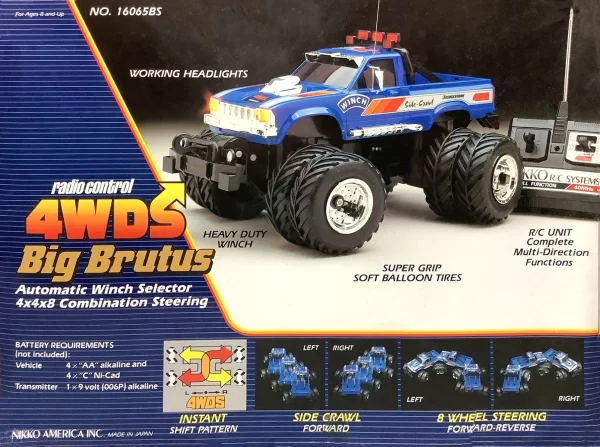Note: By popular demand, Nikko is being added; however, this topic is still being researched, and information should not be relied upon until this message disappears. If you see a mistake, please comment below or contact me.
The Nikko Big Brutus 4WDS is a 1/16 scale radio controlled monster truck manufactured by NIKKO R/C, and released into various markets worldwide in 1986. It is an impressive looking model, with dual wheels mounted in all four corners, and a working front winch and rear crane system. It was also sold as the Nikko King Crusher (see gallery).

Features and Performance
Just the facts:
- 1/16 Scale
- Four Wheel Drive (4WDS)
- Two Speed Gearbox
- Differential Front and Rear
- 8 Tires with Chrome Wheels
- Cross Mode and Parallel Mode Steering inc. Side Crawl function
- 4/8 Wheel Steering for Super Tight Turns
- Electronic Winch on Front and Crane on Back
- Working Head Lights
- Made in Japan Quality
With a 1/16 scale you might initially think the Brutus is smallish, but since it's a 1/16th of a gigantic Monster Truck, it ends up being plenty huge, though not massive like a Tamiya Super Clodbuster, but certainly big enough to live up to the name.
And with two tires mounted on each corner, much like a semi-truck or other vehicle designer to take an unusually large weight, and a host of other unique features, the Big Brutus is more than just another early 80s R/C monster pickup. That said, I wouldn't say no to a 1/10 scale Big Brutus... now that would be epic! Maybe a modified Super Clodbuster? Imagine that!
Dual Mode Four Wheel Steering
One key feature of the Brutus that may not be immediately apparent is its four-wheel-steering, referring to as '8 Wheel Steering' by Nikko on the box. This can be run in both Cross Mode and Parallel mode, meaning you could have it perform super tight turns (cross mode) or crawl sideways at an angle (parallel mode).
A necessity in real life monster trucks and many larger hobby-grade radio controlled models, it provides a much tighter turning circle for maneuvering around small areas, such as the kitchen, or monster truck stadium where the real trucks do their stunts.

Working Electric Winch and Crane
Apart from these, the main source of entertainment comes from the working electric winch mounted on the front, and the accompanying crane mechanism that hooks up to the rear tray, allowing the Big Brutus to tow another car behind it. This was selectable via its gearbox which went "Winch - Low - High".


Motor and Drive-Train
The motor(s) running the Brutus are'nt identified in the manual or packaging, and I've not the guts to take one apart quite yet, so we'll have to make some educated guesses, or wait and see if a member informs us. Around this time Nikko was frequently using Dual Mabuchi RS-380SH motors in their top-of-the-line cars, and so given this has such a large surface area to push against with those eight wheels, I'd be surprised if it didn't use a twin motor configuration similar to this. Can you confirm what it runs? Let us know in the comments!
Based on a real monster truck?
With a name and distinctive look like Big Brutus, I immediately suspected some correlation with a real life truck. And while it's not identical, I think it's fair to say that maybe some inspiration was taken from this legit Monster Truck, the real Big Brutus.
Driven by Charles Flynn from Alabama, it had six huge wheels, a Chevrolet Silverado body, a working rear tray that could tilt back, and was just plain awesome from what I can see.
Later the Silverado body would be replaced by a Lamborghini Countach body. Sweet! But was it inspiration for Nikko's little monster? I suspect there was more than a nod to this giant, given both seem to have problems stopping at the regular four wheels of most vehicles, both seem to be based on similar car bodies (technically I think the Brutus was originally based on a Hilux), and Nikko's efforts were released just 1 year after the real Big Brutus hit the stadiums.

Brother from a not-so-different mother?
At first glance I felt the Super Roader was giving off big Taiyo Hilux / Super Roader vibes, with a strong resemblance to the 1983 Taiyo 4WD Ford Ranger, and the 1986 Taiyo Toyota Hilux 4WD.
On closer inspection however, they are vastly different, except perhaps for the design style brought on by limitations of the era. Blocky and over-engineered, straight lines, rods, and angles, no suspension, etc. There was no fancy 3D Computer Aided Design back then - or well, there was, but they were mostly used by NASA, rented by major vehicle manufacturers, and doubtfully in the hands of Japanese toy designers. Mold making was all done manually by hand.


Looking deeper, the battery case design is somewhat similar. The Big Brutus did not use a separate 9V battery for its radio as the Taiyo does, though it was extremely common for many other Nikko models at the time. The 4WD driveshaft cutting through the battery bay is pretty much a necessity without adding additional motors, and is common today in modern toy and hobby grade radio controlled cars... and even real life electric vehicles! In fact, EVs bare a very strong resemblance to R/C cars, they're almost identical when it comes to the major components!


.
Alternate Identities
Also sold as the Nikko King Crusher, something I need to research further, as that may have been released as early as 1984 which might explain some of the design choices of the Big Brutus.

Availability and Collectability
The Big Brutus has such an epic 80s look that has never been reproduced in modern vehicles.
With 4WD and proportional steering (something that sadly never came to Taiyo or Tyco to any meaningful degree), it has so much potential, yet sadly is a little let down by the era in which it was released and it's deceptively small scale. Think of what a 1/10 Big Brutus would be like!
At it's core, it's early 1980s R/C engineering, and so like too many Taiyo / Tyco 4WD Pickups of the early-mid 1980s it's not as powerful and all-conquering as it could have been, though ultimately I'm all for this to be part of my collection, and I'm certain that other collectors will feel the same way despite its shortcomings.
In terms of availability, it's generally available online, even boxed versions can be found, however I doubt this will be the case for too much longer, it's just got such an iconic 80s madness to it that I bought one as soon as I saw it, and I'm sure others will do the same.






































